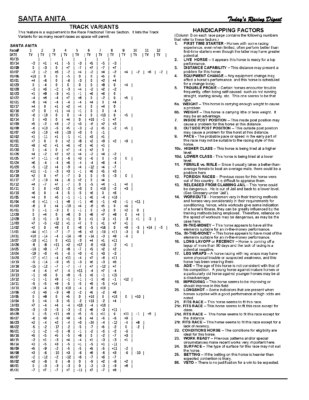How To Use Today's Racing Digest Products
How To Handicap Horses With Track Variants
How to Handicap Horses With Track Variants
It's important to understand that the recorded time of a race may not be the same thing as how fast it was. This seems like an illogical statement but there are other forces at work. On a given day, the effects of temperature, humidity, wet weather, wind, track maintenance and even the angle of the sun can have a dramatic effect on race times. To take into account these "effects" a track variant is used to adjust the speed of the race either slower or faster. The variant Today's Racing Digest uses is a measurement of the difference in time between an individual performance and our class/distance par times for each track. This is one of the most accurate ways to ensure accuracy because without an accurate variant any speed or pace figures calculated using that variant will be inaccurate.
 Today's Racing Digest's Track Variant report is a supplement to the Race Fractional Times Section. It lists the Track Variants for as many recent races as space will permit. Next to the Track Variant is a number designating the strength of the race. This number is on a scale from 1 thru 9, with 1 weakest, 5 average, and 9 strongest. These strength ratings reflect how each field measured up to the norm for their particular class level. (0 = Normal Speed: + = Faster Than Normal: - =Slower Than Normal)
Today's Racing Digest's Track Variant report is a supplement to the Race Fractional Times Section. It lists the Track Variants for as many recent races as space will permit. Next to the Track Variant is a number designating the strength of the race. This number is on a scale from 1 thru 9, with 1 weakest, 5 average, and 9 strongest. These strength ratings reflect how each field measured up to the norm for their particular class level. (0 = Normal Speed: + = Faster Than Normal: - =Slower Than Normal)

